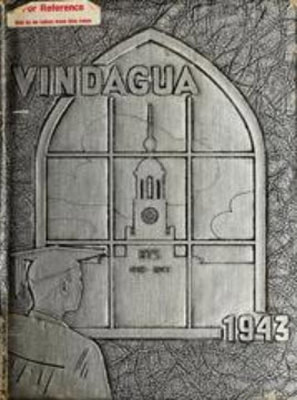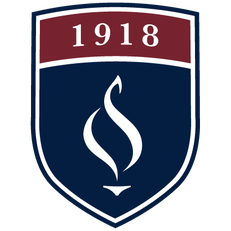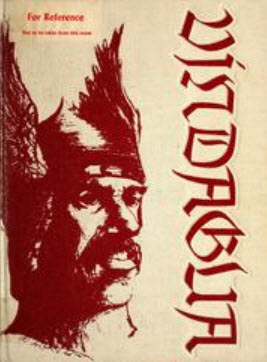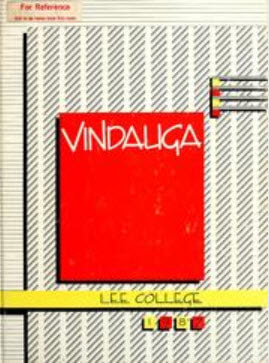Vindagua

Flipping through the pages of family scrapbooks one catches a glimpse of who people are, what they value, how they engage life, and about their hopes and dreams. It could be said Lee’s family scrapbook is the Vindagua. First published in 1942, it is one of the longest enduring traditions at Lee.
In the spring of 1941 students at the Bible Training School received permission to publish a yearbook and held a contest to find an appealing name. Gabriella McKeough, class of 1941, of Alabama knew she wanted to participate. McKeough sought the advice of faculty member Avis Swiger, who suggested she submit the name “Vindauga”, which had been the name of the school yearbook where Swiger received her teaching certificate. McKeough followed Swiger’s advice and won the contest.
“Vindauga” is an Old Norse word from which the English word “window” is derived. The name was selected for the yearbook because a window seemed an appropriate metaphor for students looking back on the experiences, people, and events of each year while also looking ahead to the future awaiting them after college.
The first yearbook staff assembled in the Fall of 1941. Dorothy Ramey Bearden, class of 1942, was a business student from North Carolina and served as treasurer. She remembers, “Horace McCracken was editor. Ren Cassels was the editorial secretary and Clifford Bridges was the business manager. I was in charge of the monies, closing the books, and sending an annual to the men who had left BTS to serve our country [during the Second World War].” Avis Swiger served as faculty sponsor. Numerous students worked to complete the 64-page yearbook in time to send for printing and binding.
When copies of the anticipated yearbook arrived in the Spring of 1942, “Vindauga” was misspelled throughout as “Vindagua.” Whether the fault of the yearbook staff or the publisher remains uncertain, but the misspelling immediately was embraced by students and faculty who chose to adopt the new spelling and pronunciation.
Over the years the Vindagua evolved with the times. It quickly increased in the number of pages, and full color images first appeared in the 1960s. The first full-color photograph other than end pages appeared in 1963. It was an image of the contestants for Parade of Favorites, which the yearbook staff sponsored originally. The yearbook staff also named “Mr. and Mrs. Lee College” for many years.
The yearbook wasn’t without controversy, however. More than once individuals voiced concern about a photo in the yearbook revealing a female’s skirt too short or a male’s hair too long. In the days when jewelry was taboo, and long before Photoshop, yearbook staff often had to airbrush images to meet appropriate standards. Then, in 1982, the yearbook staff chose to use the correct spelling of the word “Vindauga.” With mixed opinions over the name change, it continued until 1988 when faculty advisor David Tilley and the yearbook staff agreed to revert back to the earlier spelling.
After 75 years as a traditional yearbook, the Vindagua relaunched in the Fall of 2016 as a bi-annual lifestyle magazine. The new format incorporates more personal stories, focuses on topics relevant to students, and allows for greater student expression through artwork, photography, poetry, and creative design. Cariann Bradley served as editor-in-chief and creative director during this initial transition.
At Lee, the Vindagua is tradition and offers connections to people and events across the institution’s history, but it isn’t only about looking through a window into the past. Those pages serve as a reminder that friendships and various experiences help shape and strengthen one for the path ahead. As Dorothy Bearden from the first yearbook staff recently expressed, “I am pleased the name of the Vindagua remains. Even now, as students leave their college training, they look through a glass dimly not knowing what the future holds for them. But, with the help of our Heavenly Father, He continues to show the way and opens the right doors when He is sought first in their lives.”
To access the digital archives of the yearbook from 1942 through 2011, follow this link: https://leeuniversity.libguides.com/generalinfo/vindagua
/ L.F. Morgan
In the spring of 1941 students at the Bible Training School received permission to publish a yearbook and held a contest to find an appealing name. Gabriella McKeough, class of 1941, of Alabama knew she wanted to participate. McKeough sought the advice of faculty member Avis Swiger, who suggested she submit the name “Vindauga”, which had been the name of the school yearbook where Swiger received her teaching certificate. McKeough followed Swiger’s advice and won the contest.
“Vindauga” is an Old Norse word from which the English word “window” is derived. The name was selected for the yearbook because a window seemed an appropriate metaphor for students looking back on the experiences, people, and events of each year while also looking ahead to the future awaiting them after college.
The first yearbook staff assembled in the Fall of 1941. Dorothy Ramey Bearden, class of 1942, was a business student from North Carolina and served as treasurer. She remembers, “Horace McCracken was editor. Ren Cassels was the editorial secretary and Clifford Bridges was the business manager. I was in charge of the monies, closing the books, and sending an annual to the men who had left BTS to serve our country [during the Second World War].” Avis Swiger served as faculty sponsor. Numerous students worked to complete the 64-page yearbook in time to send for printing and binding.
When copies of the anticipated yearbook arrived in the Spring of 1942, “Vindauga” was misspelled throughout as “Vindagua.” Whether the fault of the yearbook staff or the publisher remains uncertain, but the misspelling immediately was embraced by students and faculty who chose to adopt the new spelling and pronunciation.
Over the years the Vindagua evolved with the times. It quickly increased in the number of pages, and full color images first appeared in the 1960s. The first full-color photograph other than end pages appeared in 1963. It was an image of the contestants for Parade of Favorites, which the yearbook staff sponsored originally. The yearbook staff also named “Mr. and Mrs. Lee College” for many years.
The yearbook wasn’t without controversy, however. More than once individuals voiced concern about a photo in the yearbook revealing a female’s skirt too short or a male’s hair too long. In the days when jewelry was taboo, and long before Photoshop, yearbook staff often had to airbrush images to meet appropriate standards. Then, in 1982, the yearbook staff chose to use the correct spelling of the word “Vindauga.” With mixed opinions over the name change, it continued until 1988 when faculty advisor David Tilley and the yearbook staff agreed to revert back to the earlier spelling.
After 75 years as a traditional yearbook, the Vindagua relaunched in the Fall of 2016 as a bi-annual lifestyle magazine. The new format incorporates more personal stories, focuses on topics relevant to students, and allows for greater student expression through artwork, photography, poetry, and creative design. Cariann Bradley served as editor-in-chief and creative director during this initial transition.
At Lee, the Vindagua is tradition and offers connections to people and events across the institution’s history, but it isn’t only about looking through a window into the past. Those pages serve as a reminder that friendships and various experiences help shape and strengthen one for the path ahead. As Dorothy Bearden from the first yearbook staff recently expressed, “I am pleased the name of the Vindagua remains. Even now, as students leave their college training, they look through a glass dimly not knowing what the future holds for them. But, with the help of our Heavenly Father, He continues to show the way and opens the right doors when He is sought first in their lives.”
To access the digital archives of the yearbook from 1942 through 2011, follow this link: https://leeuniversity.libguides.com/generalinfo/vindagua
/ L.F. Morgan


